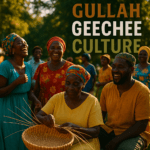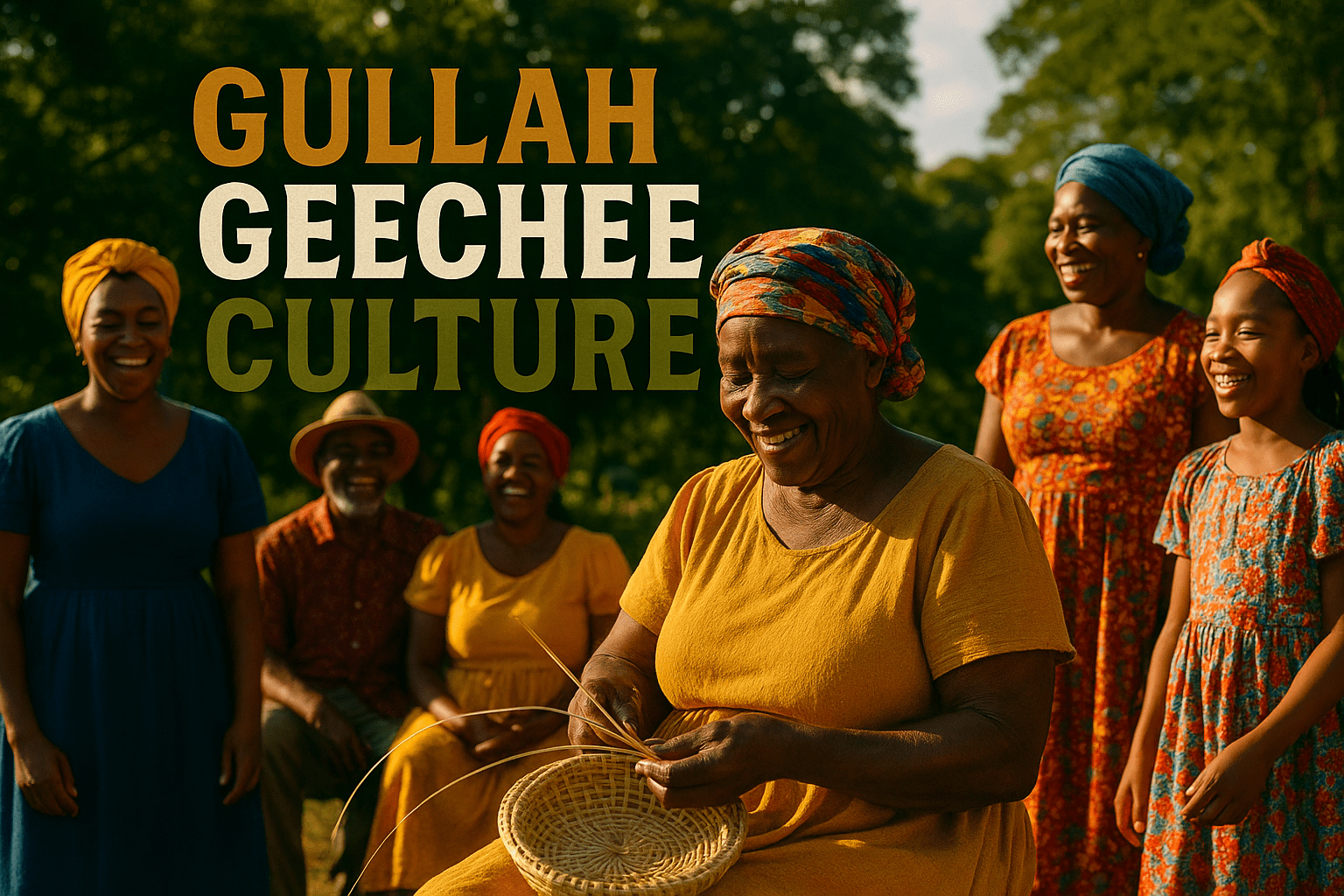

Gullah Geechee: Echoes of Ancestry
By Darius Spearman (africanelements)
Support African Elements at patreon.com/africanelements and hear recent news in a single playlist. Additionally, you can gain early access to ad-free video content.
Gullah Geechee Culture: A Living Legacy
The Gullah/Geechee people represent a distinct and vibrant group of African Americans, primarily residing along the Sea Islands of the southeastern United States. They are direct descendants of enslaved Africans brought to the coastal regions of North Carolina, South Carolina, Georgia, and Florida. Their culture stands out due to an extraordinary retention of African customs and traditions, a level of preservation rarely seen in other African American communities (tandfonline.com). This unique heritage is evident across various aspects of their lives, including their language, art, folklore, music, religion, and food.
Once marginalized, the Gullah/Geechee culture is now celebrated as a treasured heritage. There is a growing sense of pride among those who identify as Gullah and Geechee (goodmorningamerica.com). Organizations such as the Gullah Geechee Cultural Heritage Corridor Commission actively work to protect, preserve, and sustain this rich culture (goodmorningamerica.com). This heritage is not merely a historical relic; it is a living, breathing legacy that connects individuals to their African roots and to one another (gullahheritage.wordpress.com). Indeed, the culture is deeply woven into the very fabric of the community (nationalgeographic.com).
The Sea Islands: A Cradle of Culture
The Sea Islands are a chain of barrier islands stretching along the southeastern coast of the United States, from North Carolina down to Florida. These islands played a pivotal role in the preservation of Gullah/Geechee culture due to their geographical isolation. This isolation significantly limited external influences, allowing the descendants of enslaved Africans to maintain and develop their unique traditions, language, and social structures with less assimilation into mainstream American culture (thegullahsociety.com). St. Helena Island, in particular, stands as a central point for Gullah/Geechee culture (yourislandnews.com).
Key Pillars of Gullah/Geechee Culture
Language
A unique creole language, blending West African tongues and 18th-century English.
Cuisine
Strong West African influence with dishes featuring rice, okra, and seafood.
Music & Spirituals
Traditional songs like “Kumbaya” and “Roll Jordan Roll,” passed down through generations.
Praise Houses
Historic small buildings used for prayer and community gatherings by enslaved people.
Storytelling & Folklore
Rich oral traditions that convey history, wisdom, and cultural values.
Basket Weaving
An intricate craft with roots in West African traditions, often using sweetgrass.
The endurance of St. Helena Island’s native Gullah/Geechee culture is a subject of study and celebration worldwide by people of indigenous and African ancestry (yourislandnews.com). The geographic remoteness of these islands allowed Gullah people to retain a significant portion of their African culture, thereby limiting the influence of European settlers (thegullahsociety.com). This unique environment fostered a rich historic legacy for the Gullah/Geechee people, making St. Helena Island truly the epicenter of their culture (yourislandnews.com).
Praise Houses: Sacred Spaces
Praise houses are small, humble buildings that hold immense significance in Gullah culture. These structures served as gathering places where enslaved people could pray, worship, and find solace (goodmorningamerica.com). They were crucial for maintaining spiritual practices and fostering community bonds during times of immense hardship. These spaces were not merely places of worship; they were also centers for cultural expression, where spirituals were sung and traditions were reinforced.
Today, only a few of these historic praise houses remain. Mary Rivers LeGree serves as the dedicated caretaker of one of the three surviving Gullah praise houses on St. Helena Island (goodmorningamerica.com). Her efforts, and those of others like her, are vital in preserving these sacred sites, ensuring that future generations can connect with the spiritual foundations of their ancestors. These praise houses stand as tangible reminders of the resilience and faith of the Gullah people.
Cultural Protection: Safeguarding Heritage
The Cultural Protection Overlay District is a measure implemented on St. Helena Island to safeguard the Gullah/Geechee culture and land. This district serves as a critical tool to prevent rapid development, such as the proliferation of gated communities and golf courses, which could undermine the rural character and cultural integrity of the island (yourislandnews.com). The district’s primary goal is to support a healthy environment that sustains the quality of life for the Gullah/Geechee community (yourislandnews.com).
Many St. Helena Island natives and their allies actively support the strengthening of this Cultural Protection Overlay District (yourislandnews.com). This collective effort highlights the community’s determination to preserve their heritage against external pressures. The district represents a practical and legal framework designed to ensure that the unique cultural landscape of St. Helena Island remains intact for generations to come, allowing the Gullah/Geechee way of life to continue thriving.
Heirs’ Property: Land Ownership Challenges
Land ownership, particularly the issue of “heirs’ property,” presents a significant challenge for Gullah families. While the specific legal and practical details of heirs’ property are not fully elaborated, it generally refers to land passed down through generations without a clear will or formal legal documentation. This often results in multiple heirs having an undivided interest in the property, making it vulnerable to forced sales and external acquisition.
The Gullah/Geechee Nation’s website prominently features “Gullah/Geechee Land Ownership & Rights,” indicating the critical importance of this issue to the community (gullahgeecheenation.com). The vulnerability of heirs’ property poses a direct threat to the Gullah/Geechee people’s ability to retain their ancestral lands, which are intrinsically linked to their cultural identity and way of life. Efforts to address this issue are crucial for the long-term preservation of their heritage and economic stability.
Gullah Language: A Creole Tapestry
The Gullah language is a unique creole language spoken by the Gullah/Geechee people. It is often the first characteristic that captures the attention of outsiders (tandfonline.com). This language is a testament to the resilience and creativity of the Gullah people, as it developed from a blend of West African languages and 18th-century English. Its distinctiveness is a cornerstone of their cultural identity, reflecting centuries of adaptation and preservation.
The language’s origins and structure are complex, showcasing how African linguistic patterns were maintained and integrated into a new form of communication. While detailed linguistic analyses are not provided, the mere existence and continued use of Gullah highlight the community’s success in preserving a vital piece of their African heritage. The language serves as a powerful link to their past, connecting them to their ancestors and distinguishing them as a unique cultural group within the United States.
Historical Context: The Roots of Resilience
The Gullah/Geechee culture developed over time on St. Helena Island through a unique set of historical circumstances. The island’s isolation, coupled with the concentration of enslaved Africans from specific regions, allowed for the flourishing of a distinct culture. While a detailed historical timeline is not provided, the endurance of St. Helena Island’s native Gullah/Geechee culture is studied and celebrated globally (yourislandnews.com). This endurance speaks volumes about the strength and adaptability of the Gullah people.
The Gullah people’s roots trace back to West African regions renowned for rice cultivation. Sierra Leone, Senegal, Gambia, and Angola were primary sources of enslaved Africans brought to Lowcountry plantations (thegullahsociety.com). These individuals were highly skilled rice growers, and their expertise was exploited to establish the lucrative rice economy of the American South. The concentration of people from these specific regions contributed to the preservation of shared cultural practices and linguistic elements, which eventually formed the foundation of Gullah/Geechee culture.
Gullah/Geechee Cultural Origins: West African Roots
West African Regions
Primary sources of enslaved Africans known for rice cultivation: Sierra Leone, Senegal, Gambia, Angola.
Skilled Rice Growers
Enslaved individuals brought to Lowcountry plantations for their expertise in rice cultivation.
Cultural Retention
Concentration of specific groups allowed for the preservation of language, cuisine, and traditions.
Cultural Practices: Passing Down Traditions
Gullah/Geechee traditions are rich and varied, passed down through generations. These include music, storytelling, and basket weaving. The culture’s uniqueness is revealed in its art, folklore, music, religion, and food (tandfonline.com). Cooking, in particular, plays a significant role as a form of cultural preservation and community care (digital.kenyon.edu). Gullah history and culture are inseparable from their cuisine; whether at family gatherings, meetings, or baptisms, cooking serves as a means of celebration, comfort, and hospitality for both island residents and visitors (digital.kenyon.edu).
While specific details on music styles, storytelling methods, or basket weaving techniques are not provided, the emphasis on their continued practice highlights their importance. The singing of spirituals, for instance, is a profound tradition. The Voices of Gullah, an ensemble of elders, actively preserves these centuries-old spirituals, performing them in the traditional Gullah Creole language. This group, including members like Minnie Gadson, Rosa Murray, and Deacon Joe Murray, embodies the living legacy of Gullah music, ensuring its continuation for future generations.
Current Threats: Preserving a Way of Life
The Gullah/Geechee culture and land on St. Helena Island face significant threats from rapid development and infill destruction. The expansion of gated communities and golf courses directly undermines the rural character of the island and the quality of life for its inhabitants (yourislandnews.com). These developments not only displace residents but also erode the traditional landscape that is integral to Gullah/Geechee identity and cultural practices. The very essence of their community is at risk due to these external pressures.
Threats and Preservation Efforts for Gullah/Geechee Culture
Current Threats
- Rapid development and infill destruction.
- Expansion of gated communities and golf courses.
- Climatic changes and societal shifts.
- Vulnerability of heirs' property to forced sales.
Preservation Efforts
- Cultural Protection Overlay District.
- Gullah Geechee Cultural Heritage Corridor Commission.
- Advocacy for land ownership and rights.
- Community-led heritage and tourism developments.
- Environmental justice initiatives.
Furthermore, the Gullah Geechee’s cultural heritage is vulnerable to broader climatic and societal changes (repository.tudelft.nl). Rising sea levels, increased storm intensity, and economic shifts all pose challenges to the community’s ability to sustain its traditional way of life. These threats necessitate ongoing vigilance and proactive measures to protect both the physical environment and the cultural practices that define the Gullah/Geechee people.
Preservation Efforts: Community in Action
Beyond the Cultural Protection Overlay District and the Gullah Geechee Cultural Heritage Corridor Commission, numerous initiatives and community actions exist to sustain the culture. These efforts encompass a wide range of activities, including advocating for Gullah/Geechee land ownership and rights, promoting environmental justice, and fostering community-led heritage and tourism developments (gullahgeecheenation.com). These grassroots movements are vital in empowering the community to take an active role in their own preservation.
Organizations such as the Gullah/Geechee Sea Island Coalition and the Gullah/Geechee Fishing Association demonstrate the breadth of community-led efforts (gullahgeecheenation.com). These groups work to address specific challenges faced by the community, from land retention to sustainable fishing practices, all while reinforcing cultural identity. The Gullah Geechee’s cultural heritage can also be a source for enhancing community resilience and promoting more sustainable community-led heritage and tourism developments (repository.tudelft.nl). These initiatives ensure that the culture remains vibrant and adaptable in the face of modern challenges.
African Roots: A Deep Connection
The Gullah/Geechee people have been exceptionally successful in maintaining customs and traditions from Africa (tandfonline.com). Their cultural practices, language, and even cuisine bear strong resemblances to those found in West African regions. For example, Gullah cuisine, with its prominent use of rice, okra, and seafood, clearly demonstrates West African influence (thegullahsociety.com). This culinary connection is a direct link to the agricultural practices and foodways of their ancestors.
The primary sources of enslaved Africans brought to the Lowcountry plantations were regions known for their skilled rice growers, including Sierra Leone, Senegal, Gambia, and Angola (thegullahsociety.com). This specific demographic input contributed significantly to the cultural retention observed in the Gullah/Geechee community. The shared heritage from these regions allowed for the continuation and adaptation of traditions, ensuring that the echoes of Africa resonate strongly within the Gullah/Geechee culture today.
ABOUT THE AUTHOR
Darius Spearman has been a professor of Black Studies at San Diego City College since 2007. He is the author of several books, including Between The Color Lines: A History of African Americans on the California Frontier Through 1890. You can visit Darius online at africanelements.org.
